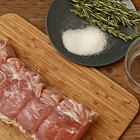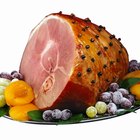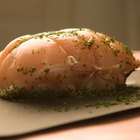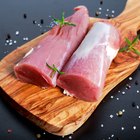
Eising/Photodisc/Getty Images
A good brine adds moisture to pork, providing a juicier, more tender meat that holds up better to cooking. And with the addition of flavoring agents, brine doubles as a marinade, too, making use of the soaking time to impart flavor. Brining time varies by the pork cut you have; generally, thinner pieces like chops only need about four hours, though they can soak as long as 24 hours, while whole pork loins can brine for up to a few days. To prevent bacterial growth, only brine in the refrigerator.
Pour cold water into a large kitchen vessel that will fully contain the pork and the solution. You need to fully immerse the pork, so if you only want to use water, fill accordingly. Otherwise, use about 2/3 water and 1/3 of a brining liquid. For this, you have many options; choose a flavor that complements the recipe you're using for the pork. Options are many, including but not limited to white or red wine, beer, sake, tea, soy sauce or tamari, any sort of vinegar, stock, broth or a fruit juice such as apple, pineapple, orange, cranberry or apple cider, among others.
Salt the liquid using either non-iodized table salt or kosher salt. Mix in about 3/4 cup table salt or 1 1/2 cups kosher salt or 2 cups crystal kosher salt per gallon of brine. Quantities aren't all the same because of differences in weight by volume of different types of salt.
Sweeten the brine with approximately 1/2 cup of an appropriate complementary sweetening agent per gallon of brine. This helps offset some of the saltiness imparted into the pork during brining and provides a more sophisticated flavor. Sugar or brown sugar are standard picks, but honey, molasses and maple syrup work as well. If you used a sweet secondary liquid, like a fruit juice or a sweet wine, consider going a little lighter on the sweetener.
Season the brine with herbs and spices if you want to further flavor the pork during soaking. Dried or fresh both work. Garlic or garlic powder, onion powder, scallions, black pepper, red pepper, thyme, bay leaves, sage, basil, clove, rosemary and oregano are just some of the possibilities. Use seasonings that appear in the pork recipe you'll be preparing, or focus on matching the flavors of your secondary brining liquid and sweetener.
Related Articles

How to Brine a Boston Butt

How to Brine a Goose

How to Brine Pork Roast

Brine for a Deer Ham

How to Use Coke to Tenderize Pork

How to Brine a Pheasant

How to Cook Pork Hamonado

How to Brine Pork Leg

How to Do Corned Pork

How to Make Salt Brine

How to Braise Pork

Adding Vinegar to a Brine for Pork

How to Make Marinade for Roast Beef

How to Brine Pork Loins

How to Brine a Turkey Using Orange Juice

Perfect Way to Cook a Pork Chop in the ...

How to Marinate Seitan

How to Marinate Steak

How to Cook Smoked Pork Knuckles

How to Cook Carolina Pulled Pork With ...
References
Writer Bio
Eric Mohrman is a food and drink, travel, and lifestyle writer living in Orlando, Florida. He has professional experience to complement his love of cooking and eating, having worked for 10 years both front- and back-of-house in casual and fine dining restaurants. He has written print and web pieces on food and drink topics for Visit Florida, Orlando Style Magazine, CrushBrew Magazine, Agent Magazine, Dollar Stretcher Magazine, The 863 Magazine and other publications.
Photo Credits
Eising/Photodisc/Getty Images